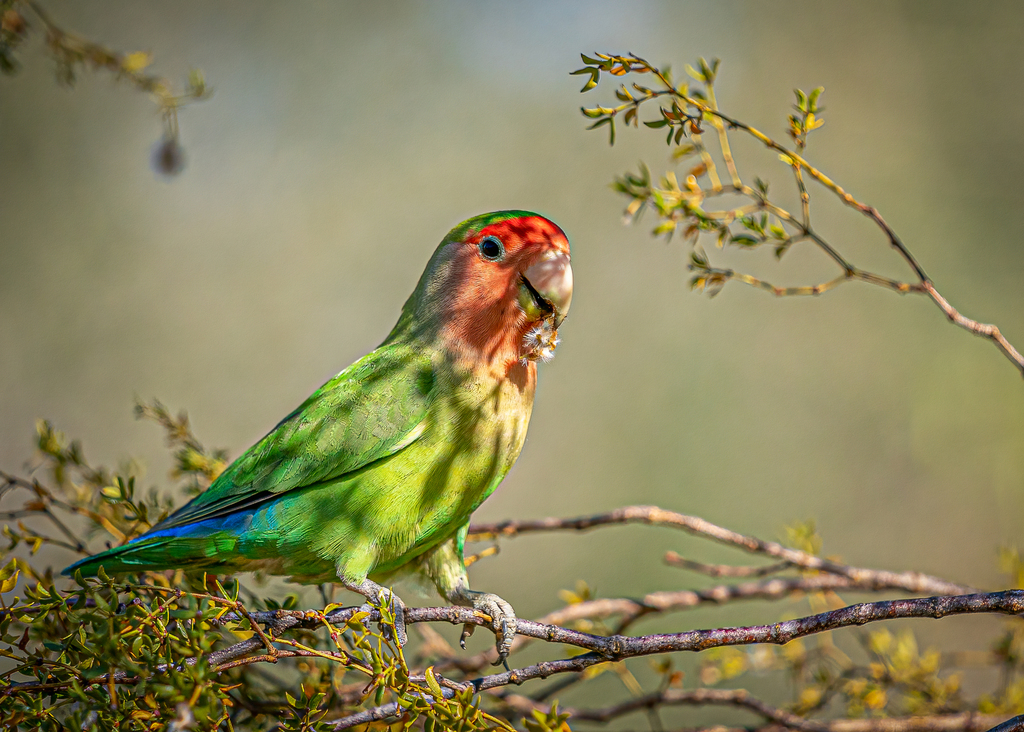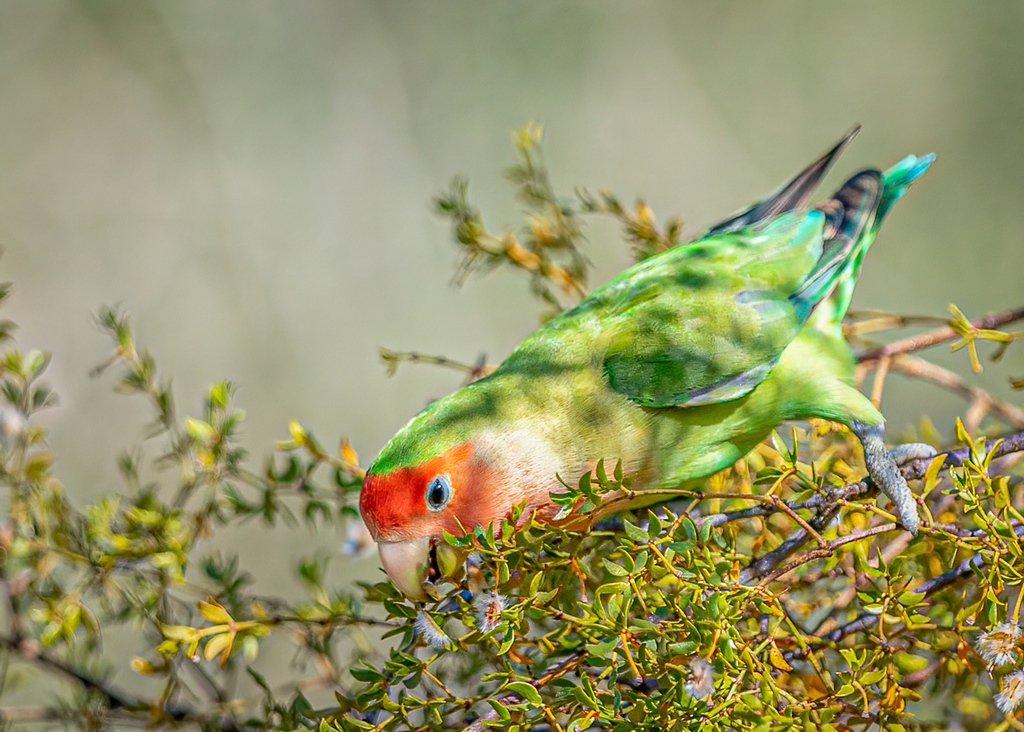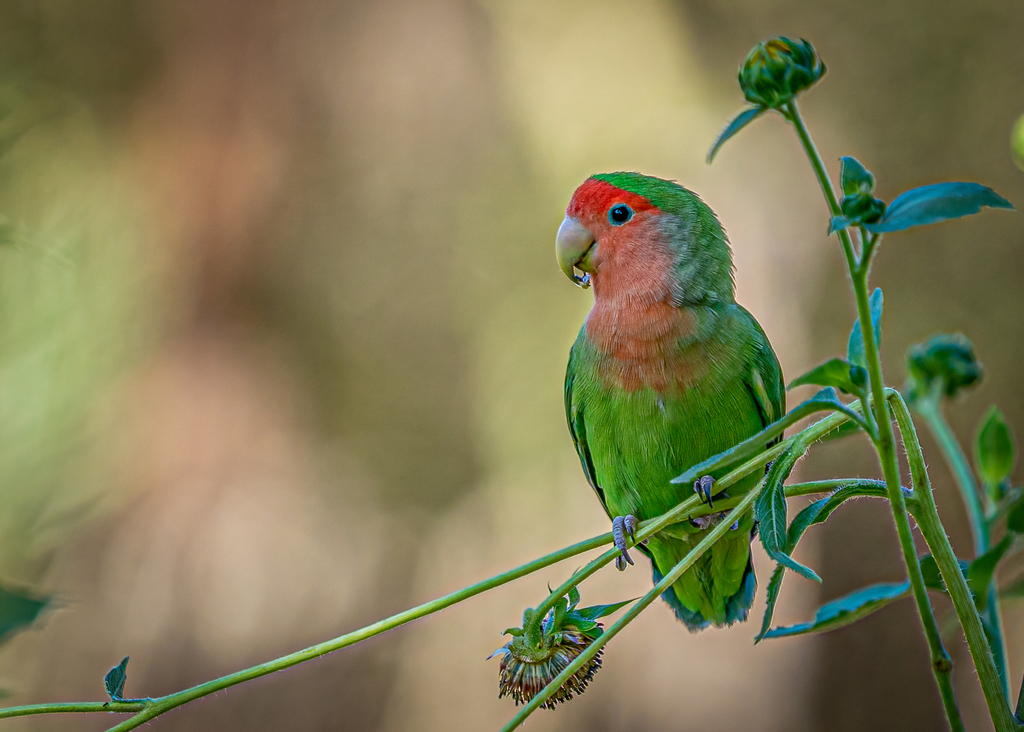Join the August EcoQuest: Look Out for Lovebirds
Find and map as many rosy-faced lovebirds (Agapornis roseicollis) and the plants they interact with as possible.
Join the EcoQuest
See lovebirds on eBird
All lovebird photographs in this post kindly provided by project member
@reaglephoto.
See more here!
Rosy-faced lovebirds can be seen all over the Valley and are adored by many. Often thought of as a native bird, these cheeky characters were actually introduced to the area. Observations from this month's EcoQuest can help us learn more about how these colorful parrots have adapted to life in metro Phoenix.

The population of rosy-faced lovebirds in metro Phoenix is unique in that most lovebirds that escape captivity don’t seem to be able to establish feral populations. This is true even in their native habitat of arid regions in southwestern Africa. The population in the Valley is believed to have been here since the 1980s and is thought to be the result of accidentally escaped pets and illegal intentional releases into the wild. These clever birds have found ways to survive in urban areas and are not entirely dependent on humans. As of 2020, their population is estimated to be about 2,000-3,000 and their range appears to be expanding along with urban development.
Rosy-faced lovebirds are smart and resourceful. Phoenix is one of the fastest warming cities in the country, and the heat is especially intense is urban areas. Lovebirds have figured out at least one way to stay cool in the sweltering temperatures. After hearing numerous reports of lovebirds near air conditioning vents on campus, Kevin McGraw, who runs a behavioral ecology lab at Arizona State University, studied the cheeky parrots with students. The study showed that on the hottest and most humid days the greatest number of lovebirds flocked to take advantage of the cool air being leaked from the vents, something native birds haven’t really been observed doing. They have also been able to figure out native food sources like mesquite, creosote and cactus fruit, making them not entirely dependent on bird seed and other human provided food sources. They can most often be found roosting and nesting in palm trees, tile roofs and saguaros, making the most of their surroundings.
How this species impacts other native wildlife hasn’t been scientifically studied. Although technically an invasive species, most evidence suggests that rosy-faced lovebirds are mostly benign because they don’t seem to be able to survive in more natural desert areas. The greatest competition to native wildlife is likely for food and roosting and nesting sites in urban areas. Climate change will impact both native and non-native species, and it will be interesting to see how lovebirds and other wildlife adapt, specifically in urban settings. Will lovebirds be able to tough out the higher temperatures with creative solutions like seeking out air conditioning leaks while native birds are left in the heat? Disease is another impact to consider. Lovebirds can have psittacine beak and feather disease, as well as Chlamydia psittaci which can infect other bird species and cause illness in humans. Research and studies are needed to learn more about the potential impacts.

It’s fascinating to see how an introduced species can adapt to a new environment, especially an urban one. Thanks to the work of the Arizona Field Ornithologists, we have a lot of information and data on this feral population. As is the way with science, there’s always more to learn! There could be plants we don’t know they are eating, or they could be interacting with other birds in ways we aren’t aware of. Help us learn more about rosy-faced lovebirds.
Fun fact: Did you know there was once a native parrot found in Arizona? The thick billed parrot (Rhynchopsitta pachyrhyncha) inhabited higher elevations in the forests near the Chiricahua Mountains until it was hunted into local extinction. The last sighting of one in Arizona was in 1938, but it can still be found in Mexico.

Observations from this EcoQuest can contribute population and occurrence data for rosy-faced lovebirds (Agapornis roseicollis) and we can learn more about their relationships with plants and other wildlife in metro Phoenix.
WHAT TO OBSERVE:
Common Name: Rosy-faced lovebird
Scientific Name: Agapornis roseicollis
Family: Psittaculidae
Origin: Southwest Africa
Lovebirds can often be found near water sources, especially with palm trees or houses with roof tiles nearby. Bird feeders are also a common place to spot them. Use iNaturalist to see where they’ve been spotted in the past! You can also upload lovebird sounds to iNaturalist as observations. Check it out.
See lovebirds on eBird
See them on iNaturalist
Associated Plant Species:
Saguaro (Carnegiea gigantea)
Creosote (Larrea tridentata)
Palms (Arecaceae)
Cactus (Cactaceae)
Mesquite (Prosopis spp.)
Palo verde (Parkinsonia spp.)

SOURCES AND MORE INFORMATION:
Arizona Field Ornithologists
Greg Clark
Audubon Society
Maricopa Audubon Society
Animal Diversity Web
Rosy-faced Lovebirds and Disease
KJZZ

Sign up for our newsletter and stay connected.
Visit our website.
Let's be social @ ecofloraphx

Let's be social.On Instagram, Facebook, and Twitter.
PLEASE observe COVID-19 guidelines/recommendations.
This a great opportunity to get outdoors close to home as we all navigate the complications of COVID-19. However, it is imperative that you follow the guidelines/recommendations of your local governments and institutions (wear a mask, practice physical distancing and wash your hands). Do what’s best for you and your community.
Arizona Office of Tourism: Responsible Recreation in AZ
https://tourism.az.gov/responsible-recreation-across-arizona
Please do not observe indoor houseplants or pets.
For your own safety and the protection of plants and wildlife, do not trespass when making observations. Please follow all posted rules and guidelines in parks/preserves and do not enter private property.
Do not remove or move natural materials (plants, animals, rocks).
Respect wildlife (do not touch, feed, or disturb animals and keep a safe distance).












